In this article, you’ll learn what is a pulley? how does it work? Its parts, working, applications, and types of pulleys are explained with examples and pictures.
Download the PDF file of this article at the end of it.
What is Pulley?
Pulley is a mechanical component used to transfer motion from shaft to belt or rope and vice versa. Pulleys and belts are the most easiest and common mediums of power transmission.
A pulley is a type of wheel on a shaft designed to change the direction of a belt and to support the transfer of power between the shaft and belt. A pulley has a groove inside the flange around its circumference to hold the cable or belt.
The main element of a pulley system is a rope, cable, belt, or chain. Pulley is fixed on the shaft or pulley which moves other pulleys and are called “Driver Pulleys”. The pulleys moved by the driver pulley are called “Follower Pulleys”. Pulleys are available in small and big sizes.
We can easily increase or decrease the speed of power transmission in terms of gears and shafts by using large and small pulleys.
You might like: Understand Different Types of Springs and Their Applications
Parts of Pulley
Following are the parts of a pulley:
- Face
- Hub
- Arms
- Bore
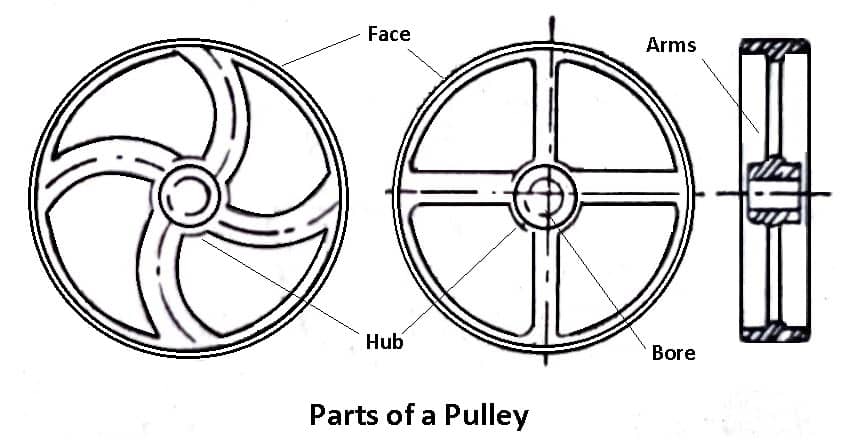
#1 Face
The part containing the periphery of the pulley is called the Face. It extends somewhat from the center and is descending from the sides. The protruding middle part is called the Crown. The face is either plain or a “V” groove is built on it.
#2 Hub
The hub is a central part of a pulley, which has a bore for the shaft. There are three types:
a) Solid Hub: It is only a shaft of one particular size that is fitted. For shafts of different sizes, it is used with different bores.
b) Slotted Hub: It is slotted from one side which is tightened with a nut and bolt after fitting the shaft. It is also made in one piece. It can be used with shafts of different diameters.
c) Split Hub: This type of hub is made in two parts. For fitting these two parts on the shafts two nuts and bolts are used. Their faces are made of two pieces. These can be used for big and small shafts of the same type.
#3 Arms
The joining parts which join the face and hub of the pulley are called Arms. Their number is according to the diameter of the pulley and its use. It may be made with four, six, or eight.
#4 Bore
The hole in the hub is called Bore. A key way is to cut in the hole, with the key shaft and pulley locked.
You might like: Different Types of Cutting Tools & Their Uses
Types of Pulleys
For different machines and jobs, the following types of pulleys are used:
- Fixed pulley
- Movable pulley
- Compound pulley
- Block and tackle pulley
- Step pulley
- “V” groove pulley
- Cone pulley
- Jockey pulley
- Round pulley
- Fast and loose pulley
- Conveyor pulley
Read Also: 12 Different Types of Fasteners and Their Uses [PDF].
#1 Fixed Pulley
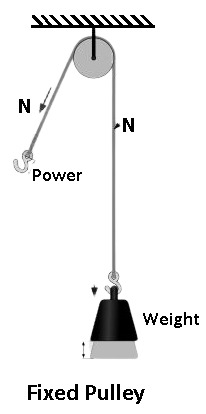
In this type of pulley system, the pulley is attached to a fixed point and the rope is attached to the object. The wheel and axle of the fixed pulley are designed to lay in one place. It consists of a drum that is attached to a single spot.
In this, you pull one side of the rope downwards and the other side upwards. You use the same force to pull it down as you do to lift the object by hand yourself. However, the direction of the force is changed. This is useful because when you pull down, you can use your own body weight to push.
#2 Movable Pulley
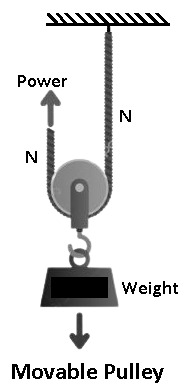
In this type of pulley, the rope is attached to the fixed point and the other end of the rope is left free. The pulley is attached to the object that you need to move. When you pull the rope, it moves and the pulley lifts the object. This system is perfect for raising the object below you to a higher level.
If both sides of the movable pulley system are fixed and the rope is stretched between fixed points, the system works like a wheel and axle because the object can travel along the rope if a force is applied to it.
#3 Compound Pulley
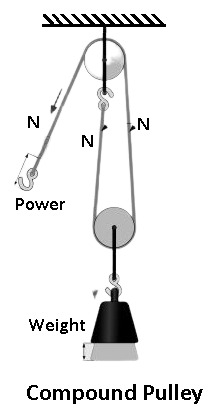
In the case of a compound pulley, it consists of fixed and movable pulleys, which makes the load lighter and allows you to change the direction of the force. These are ideal for very heavy loads, however, sometimes you need much speed to do the job properly.
It is designed to put the effort you’re loading at less than half the actual load. These systems are typically installed on construction sites and on cranes to lift heavy objects such as concrete and steel. It is also known as a combination pulley system.
#4 Block and Tackle Pulley
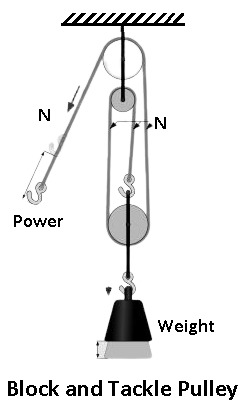
A block and tackle pulley is a system of two or more pulleys held together by rope or cable to lift massive loads. These types of pulleys are arranged to form a block and then the blocks are connected so that one is stationary and moves with a load.
To give a mechanical advantage, the rope is threaded into the pulley which increases the force applied to the rope. These pulleys are generally used for lifting heavy weights or applying great force in any direction.
#5 Step Pulley
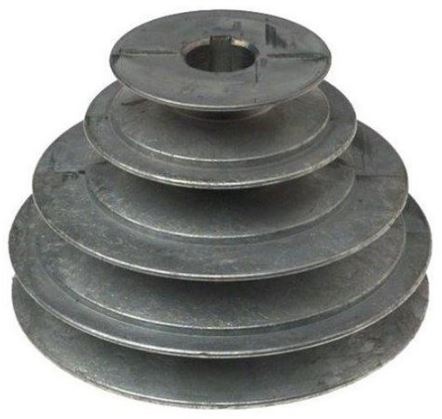
This can be termed as a group of several pulleys. Pulley faces are made into step pulleys, with pulleys of different diameters fixed in sequence. As it is made like steps it is known as a step pulley.
It is used in places where there is a need to increase or decrease the speed of the driven pulley for various jobs e.g. drill machine, lathe machine, etc. These are often used in pairs.
#6 “V” Groove Pulley
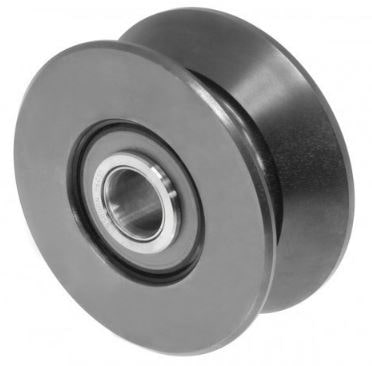
A groove like the English letter “V’ is cut on the face of this pulley. It is used in electric motors and automobiles. A special “V” shape belt is used with these pulleys. In some pulleys, more than one “V” groove is cut.
These types of pulleys are used for power transmission for heavy jobs. With the use of more than one “V” belt, there are fewer chances of a slip of power.
#7 Cone Pulley
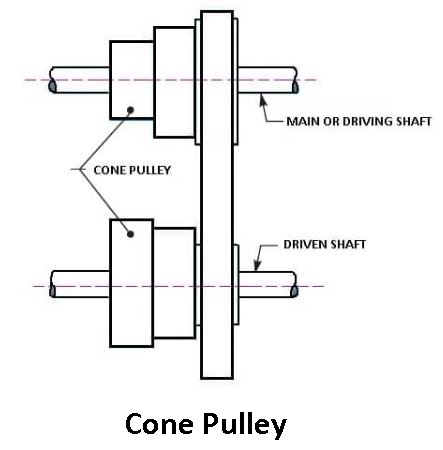
It is used in a set of two pulleys (pairs) and is tapered. A similar taper is cut on two pulleys. These are fitted in such a way that the large end of one is opposite the small end of the other so that the movement of the belt causes a change in speed. With the help of this pulley, we can get appropriate speeds for different jobs.
#8 Jockey Pulley
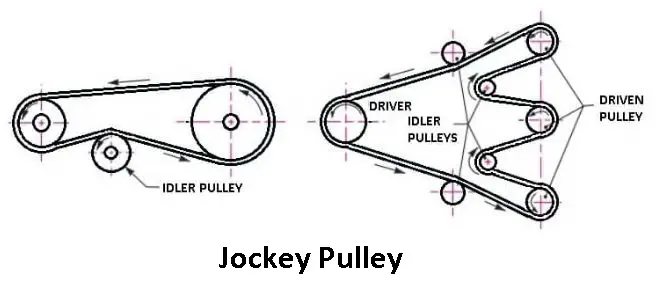
One problem that usually comes up while using these pulleys is that after some time their belts become loose and start slipping, resulting in loss of power.
In order to overcome this problem, a third pulley is used with the pair of two pulleys as shown in the figure. It is called a jockey pulley. This pulley is a self-controlled pulley that keeps the belt tight when it becomes loose.
#9 Round Pulley
A round groove is cut on the face of this type of pulley. Round belts or ropes are used to operate it. It can also be made like the step pulley.
#10 Fast and Loose Pulley
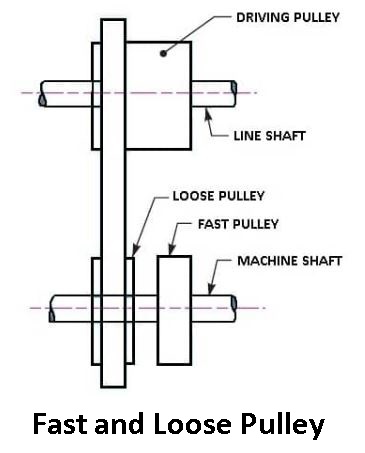
These pulleys are used for the machines which are quickly started or put off. These are used in pairs of two small pulleys, which are fitted on a countershaft. One pulley is tightened on the countershaft with a ‘key’ or some other medium and another pulley is fitted through a provision for free rotation.
When the machine is to be operated, the belt is mounted on the tight pulley. This pulley is known as a fast pulley. When the machine is to be put off, the belt is slipped onto the independent pulley, which is known as a loose pulley.
Its major advantage is that we can shut down the machine still the main shaft running with an electric motor or oil engine keeps rotating. A lever is provided for slipping the belt.
#11 Conveyor Pulley
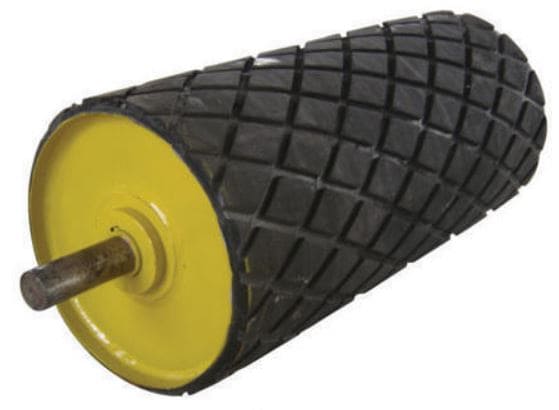
These types of pulleys are used as driver pulley on the countershaft of those machines which are operated by one single electric motor or oil engine and by one countershaft. Their faces are made appropriately broad and flat belts are used.
The conveyor system uses a conveyor pulley to help change the direction of the conveyor belt, operate the belt, and provide tension to the belt.
These are made of rolled shells with flexible end discs and locking assemblies. They are placed at one end of the conveyor or next to the conveyor on a motor.
You might like: What Are The Common Types of Corrosion in Metals?
Flat Belt Pulley
Flat belt pulleys are ideal in transmission systems. These are driven by flat belts, typically have high speeds, and are used in low-power applications in textiles, paper making, computer printers, and conveyors.
The flat belt is cheaper than the belt used in a serpentine belt pulley. Flat belts operate on flat pulleys and flat pulley idlers and do not require a grooved flat belt pulley. A flat pulley idler can also be used for the rear of a traditional V-belt.
One advantage of using this pulley is that in the event of over-torque, the belt may slip, thereby avoiding damage to equipment other than the belt.
Types of Flat Belt Pulleys
Following are the types of flat belt pulleys:
- Split or Cast iron pulley
- Paper pulley
- Steel pulley
- Wooden pulley
#1 Split or Cast Iron Pulley
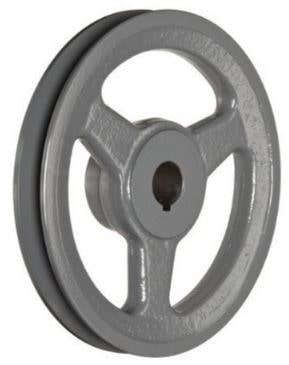
These types of pulleys are made of cast iron and have round rims. This type of pulley is made up of two parts, which are the face and the hub. Its specialty is that it can be used on pulleys of different sizes, big and small. It is used in a saw machine.
They are used in various industrial sectors. Cast iron pulleys are often used in oil extraction and also in engineering industries. Due to the low cost of the pulley, they are affordable for every industry.
#2 Paper Pulley
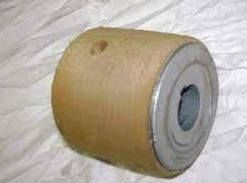
The paper pulley is made in such a way that the outer part of the pulley is made of compressed paper fibers and the inner part is of metal. This type of pulley is fitted with an electric motor to a belt transmission system when the center-to-center shaft distance is short.
#3 Steel Pulley
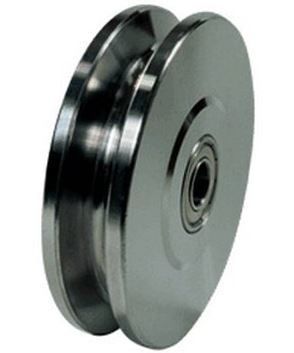
As the name suggests, these pulleys are made of steel sheets. This pulley is made into two parts that are bonded together. Steel pulleys are equipped with interchangeable bushings with shafts of different sizes.
A steel pulley provides a coefficient of friction with a leather belt that is at least equal to that achieved by a cast-iron pulley. They are stronger, more durable, and lighter in weight ( up to 40 to 60% less) than iron pulleys. These pulleys are typically designed to run at high speeds.
#4 Wooden Pulley
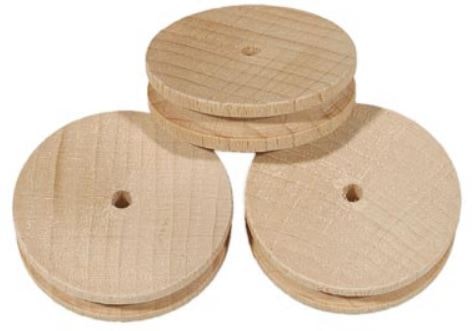
Wood pulleys are light in weight and have a higher coefficient of friction compared to cast iron or steel pulleys. They are made of maple that is placed in sections and glued together under heavy pressure.
These pulleys are maybe solid or split with iron hubs fitted by screws or adjustable bushings that prevent frictional resistance from being installed between them and the shaft. They are mostly used in motor drives because the contact arc between the pulley face and the belt is limited.
You might like: Different Types of Welding Machines & Their Uses
Advantages of Pulley System
- The effort is reduced when lifting heavy loads with pulleys, thus providing a mechanical advantage.
- The process of lifting things is silent, so it is a noiseless process.
- It can change the direction of the applied force.
- This minimizes the amount of actual force required to lift heavy objects.
- Pulleys are cheaper and easy to manufacture than gears.
- However, the pulley system consists of moving parts, so no lubrication is required.
Disadvantages of Pulley System
- It uses friction when it works to transfer motion so there is a possibility of slip.
- It is not suitable for very high-power transfer at high rpm.
- The rope causes fatigue and creeps when working for a long time.
- If you are lifting heavy objects, the lifting distance can be increased.
- Pulley systems are not reliable when compared with gear systems.
Examples of Pulleys
The following are common examples that show where pulleys are used.
- In elevators, it uses multiple pulleys to perform the task.
- A cargo lift system is a pulley system that allows objects to be hoisted to higher floors.
- The Construction pulleys are used to lift and hold heavy materials in place.
- Several exercise equipment use pulleys to perform their functions.
- In theater, films are moved using a pulley system that separates the screens.
- The glasses on the windows are operated using a pulley system to move them up and down.
- The clothesline uses a pulley system to easily pull the clothes towards the customer.
- Roofers can also use pulleys to raise the roof instead of attempting to take all the shingles up.
- You do not know that a crane is a type of pulley system that is used in construction.
- The bulldozer is also a great example that uses a pulley system.
- A pulley is used to extend the ladder.
- The sails on sailboats are lifted and dropped using a pulley system.
- Garage doors use a pulley system to raise and lower the door.
- People who go rock climbing use pulleys to help them climb.
- The timing belt in cars is a perfect example of pulley.
Closing It Up
As we discussed above, a pulley is a wheel with grooved rims that works to change the direction of the force exerted on the rope and is used to lift heavy weights. There are many pulleys and their functions also differ from each other.
If you still have any questions about “types of pulleys” you can ask in the comments I’ll respond to you. If you like this article then share it with your friends.
Subscribe to our newsletter.
Download PDF of this article
Read more interesting articles on our blog:
- What is Coupling? Its Parts, Types, Working and Uses
- What are the different types of cams and followers?
- Types of Pattern and Pattern Allowances
- How Does A Woodruff Key Works?
- Different Types of Welding Joints (Explained in Detail)
- Different Types of Fits Used in Metrology
- What is Shaft Coupling? How does it work?
- What Are The Types of Spanners and Their Uses?
- 13 Different Types of Threads [Complete Guide]
- Different Types of Rolling Mills and Their Working
References:
FAQs
A pulley is a straightforward mechanical device that consists of a flexible rope, cord, chain, or belt that is supported on a wheel’s rim.
The various types of pulleys are as follows:
1. Fixed pulley
2. Moving Pulley
3. Compound Pulley
4. Block and Tackle Pulley
5. Step Pulley
6. Cone Pulley
7. “V” Groove Pulley
8. Jockey Pulley
9. Conveyor Pulley
10. Fast and Loose Pulley
Very good
Thank you.